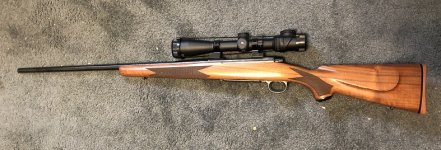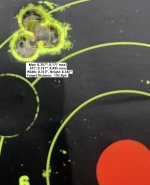stagpanther
New member
Last year a customer of mine brought me his daughter's Model 70 in 270 wby magnum to fix up and put a new scope on; trijicon's aimpoint 2.5 x 12.5. The original wood stock was in pretty bad shape, the fore end was warped (plus was filled with some really weird fiberglass and rubber cement-like stuff) and the inlets were rough, the primary bolt holes were compressed and hairline cracked and the magazine floorplate was binding because of year's of overtorqueing had distorted the bottom-metal inlet. The rifle is about 30 to 40 years old and was handed down from grand dad to dad and now it's her's.
At the time I told her it was a pretty hopeless cause (plus I'd never worked on a model 70 before) and recommended she buy a hoque overmolded stock with full-length pillar bedding--especially since she hunts often in the winter.
She did OK with it, but she said she just never liked it as much as the old stock--so I told her and her daddy I'd try my best to fix it up as best I could. Down the rabbit hole I went!
After hand grinding the foreend to free-float the barrel, the biggest problem was the lug inlet and front bolt hole--they had been badly pounded and distorted over time--plus the lug inlet was filled with some bizarre rubber-like compound (maybe that's what they did back then?) I decided to mill the inlet out and deepen it a bit, as well as put a 3/8ths steel front pillar in. All of this became a solid block of devcon plastic steel. The rear bolt hole doesn't have enough room for that so I put a 5/16ths one in there. I fashioned another pillar for where the bolt goes through the front of trigger guard to keep the bottom metal from compressing down and binding the magazine plate.

Much to my own surprise--it all actually works and I didn't ruin the stock! This afternoon I took it out to do some basic function checking, and my friend's daughter shoots exclusively weatherby's factory 150 partitions, so I had to borrow some from her to get the rifle tested. She wants it zeroed to 200 but I couldn't get that distance today due to machinery in the way, so I had to settle on 192 yds and leaving it a bit high. It took me 6 shots to get in the ballpark, I was a bit stumped on using the scope's turrets, it's a 1/4 MOA schema (so I halved that at 192 yds for approximate adjustments) but found the bullet impacts were going much further off than I thought they would. I'll have to download a manual and see what it is I'm doing wrong. After finally getting on paper and letting the barrel cool, I shot this (honest) 3 shot group (the barrel gets very hot very quickly).
This afternoon I took it out to do some basic function checking, and my friend's daughter shoots exclusively weatherby's factory 150 partitions, so I had to borrow some from her to get the rifle tested. She wants it zeroed to 200 but I couldn't get that distance today due to machinery in the way, so I had to settle on 192 yds and leaving it a bit high. It took me 6 shots to get in the ballpark, I was a bit stumped on using the scope's turrets, it's a 1/4 MOA schema (so I halved that at 192 yds for approximate adjustments) but found the bullet impacts were going much further off than I thought they would. I'll have to download a manual and see what it is I'm doing wrong. After finally getting on paper and letting the barrel cool, I shot this (honest) 3 shot group (the barrel gets very hot very quickly).

At the time I told her it was a pretty hopeless cause (plus I'd never worked on a model 70 before) and recommended she buy a hoque overmolded stock with full-length pillar bedding--especially since she hunts often in the winter.
She did OK with it, but she said she just never liked it as much as the old stock--so I told her and her daddy I'd try my best to fix it up as best I could. Down the rabbit hole I went!
After hand grinding the foreend to free-float the barrel, the biggest problem was the lug inlet and front bolt hole--they had been badly pounded and distorted over time--plus the lug inlet was filled with some bizarre rubber-like compound (maybe that's what they did back then?) I decided to mill the inlet out and deepen it a bit, as well as put a 3/8ths steel front pillar in. All of this became a solid block of devcon plastic steel. The rear bolt hole doesn't have enough room for that so I put a 5/16ths one in there. I fashioned another pillar for where the bolt goes through the front of trigger guard to keep the bottom metal from compressing down and binding the magazine plate.
Much to my own surprise--it all actually works and I didn't ruin the stock!


